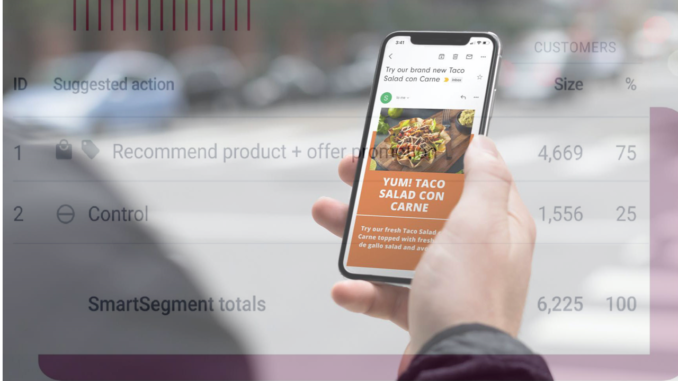
By Ben Straley, President and Chief Product Officer at Brightloom - 12.7.2021
Businesses today recognize the importance of a data-driven approach to customer engagement. While early adopters like Starbucks, Domino’s Pizza, and Panera have transformed their businesses by leveraging customer data, many businesses have yet to unlock the almost unlimited potential of data science to elevate customer experience and accelerate business growth. The window for change is now open to all.
Restaurant operators continue to face an onslaught of business challenges — from labor shortages to COVID-driven inventory delays to customers’ rapid adoption of new digital channels. Understandably, resource-strapped brands hesitate to take on complicated data projects or overhaul outmoded technical ecosystems. Yet, pandemic-driven uncertainty and massive market shifts highlight the value of data and models that make predicting the future possible. Data science holds the keys to capturing this value.
At the core, data science uses data to make accurate predictions about the future. The advent of cloud computing combined with incredible data processing power has opened the door to prediction-driven decision making at massive scale. Data-powered insights that reveal hidden patterns in customer behavior and accurate predictions about future results that previously took weeks and months now only take hours or, in a growing number of cases, milliseconds to generate.
Insights and predictions derived from data science support enable smarter business decisions, improve customer engagement, and drive incremental revenue. Following are three ways restaurants can use their own data and apply data science practices to strengthen customer loyalty in the face of a tumultuous market.
Show (don’t tell) that you know your customers
People often conflate data analytics and data science. Data analytics is inherently retrospective whereas data science is predictive. Data analytics are used to illustrate, explain, and provide insights relating to activities and events that occurred in the past which contributed to a restaurant’s sales, COGS, and profit margin last quarter. Data science provides reliable predictions of what sales, COGS, and margins a restaurant should expect next quarter using different inputs and assumptions. It is an invaluable tool to support business teams in scenario planning and deciding which strategy and tactics have the best chance at achieving their quarterly goals. For example, a coffee and breakfast chain might use data science to increase the lifetime value of their loyalty program members through personalization of each member’s rewards.
Here’s a more detailed hypothetical example of how data science enables a restaurant to increase top and bottom line results by moving a brand away from “spray-and-pray”, highly inefficient promotions to tailored, data science-powered product and promotional offers. Let’s say a restaurant’s most popular smoothie flavor appeals to roughly 30% of its customer base. A standard, one-size-fits-all promotion of this smoothie sent to all of the brand’s customer base will alienate ~70% of the recipients due to an irrelevant promotion. A missed opportunity for many and even worse for the recipients who unsubscribe due to irrelevance, annoyance, or both. By using data, experimentation, and data science, the restaurant can accurately predict what each customer is likely to buy and match far more relevant, personalized offers to every customer. By taking this approach, the restaurant is much more likely to capture more sales, increase brand affinity, and trigger fewer opt-outs.
Leverage new technology to deliver personalization at scale
Restaurants with time and budgets could build a dedicated team of marketers and data scientists to evaluate customer behaviors and make informed decisions about future customer engagement strategies. However, this practice quickly becomes unsustainable as the customer base and volume and complexity of transaction data grows. Even if a restaurant had a small enough customer base to undertake this manual approach, realistically it wouldn’t have the resources to execute effective customer engagement campaigns.
Bespoke data science techniques and models automated through software can work in some cases but they are typically costly to set up and difficult to maintain. This is for two reasons:
- Scarce data science expertise: As a relatively new field, data science expertise is in high demand. LinkedIn’s 2020 Emerging Job Report found that data scientists are the third most in-demand role in the U.S.
- Limited time and resources: Aside from identifying talent, many restaurants don’t have the time or resources to build and maintain a robust data science operation.
Fortunately, there’s an emerging category of SaaS solutions that enable and automate data-science driven business optimization and customer engagement strategies. These SaaS partners can help restaurants better understand the unique behavior patterns of their customers, surface latent customer preferences and recommend the best channels to engage customers.
Even with the right partner and technology on board, many restaurants don’t have a game plan or know where to start. In my experience there are a couple of initial steps that are crucial regardless of a restaurant’s digital maturity: cadence, channel, and consistency. First, data scientists must strategize the best cadence of customer communication whether it be trigger-based, weekly, monthly, or more frequent. Next, they’ll identify the best channel or channels to engage each customer (e.g. email, push, SMS, etc.). Showing up consistently through the right channels at the right time is paramount to building trust with customers.
Drive and measure incremental revenue
In my 20-plus years working in the digital marketing space, I’ve seen a range of sophisticated marketing strategies — from fast-growing upstarts to gold-standard industry leaders. Today it is as true as ever that many consumer brands struggle to understand the true incremental ROI of their promotions.
Leaders who set out to accomplish any business objective whether it’s driving additional revenue or increasing their subscriber base, must seek to understand the degree to which input X (e.g. a promotional offer email) produced output Y (e.g. increased foot traffic and sales). What results did they actually drive versus what results were produced by another factor or due to random chance?
Data science introduces a new opportunity to redefine success and dimensionalize how restaurants measure ROI. Data scientists routinely use one of a number of statistical tests to quantify the probability that the result of a marketing campaign was due to something other than chance. This is usually referred to as a p-value, a value used to quantify the confidence in the predictability and repeatability of a given result. Marketing campaigns that produce positive results with a p-value of less than .05 (i.e. the result has less than a 5% probability it was due to chance) have a high likelihood of producing another positive result if run the same way in the future. It’s statistics applied to marketing data.
Think about the power of this approach for marketers. Marketers can replace uncertainty about the ROI of their campaigns with data-driven decision making informed by probabilities and predictions of what strategies will produce optimal results at scale and over the long run. Investments in marketing that produce low p-value outcomes are the stepping stones to high-ROI campaigns and programs. Ultimately, data science predicts the incremental impact of every customer touchpoint and promotional campaign so that brands can learn what to do next to optimize effectiveness in the future. Business leaders today don’t view ROI through this lens, but they should and will in the future.
Jumpstart the customer loyalty flywheel with data science
With the massive spike of digital customer interactions over the past two years, restaurants are sitting on a treasure trove of customer data. The opportunity is to understand what data is most valuable and how to make it actionable. Data science holds the key to unlocking more robust and profitable restaurant loyalty programs. With 2022 upon us, now is the time for restaurants to reevaluate their customer engagement strategies and how data science can help. With refined promotional offers, the ability to activate quickly and consistently, and newfound confidence in campaign results, restaurants can continue to compete and thrive in the face of ongoing market disruptions and uncertainty.
 Ben Straley is President and Chief Product Officer at Brightloom, an all-in-one customer experience and engagement platform for restaurant brands. Previously, he led the worldwide deals business and outbound marketing channels at Amazon. Prior to Amazon, Ben led Global Digital Products at Starbucks and was responsible for customer-facing product strategy, design, and engineering of the Starbucks digital flywheel platform including mobile ordering, payment, and loyalty.
Ben Straley is President and Chief Product Officer at Brightloom, an all-in-one customer experience and engagement platform for restaurant brands. Previously, he led the worldwide deals business and outbound marketing channels at Amazon. Prior to Amazon, Ben led Global Digital Products at Starbucks and was responsible for customer-facing product strategy, design, and engineering of the Starbucks digital flywheel platform including mobile ordering, payment, and loyalty.
Are you an industry thought leader with a point of view on restaurant technology that you would like to share with our readers? If so, we invite you to review our editorial guidelines and submit your article for publishing consideration.

